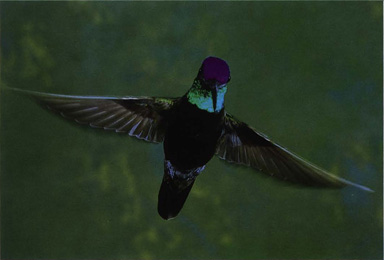
Eugenes fulgens
A Southwestern Hummingbird

Magnificent hummingbird, male. A large bird with dark belly, green throat, and purple crown. Length: 5.25 inches. Female (not pictured), green head and back, light underside, dark bill, white eye stripe, and no white “whisker.”
Used to be Rivoli's
The former name of this species was Rivoli's hummingbird, in honor of Francois Victor Massena, the Duc de Rivoli. He was an ardent collector of birds, especially hummingbirds, and it was his lovely wife after whom the Anna's hummingbird was named.
Although it is always hard to get used to name changes, the adjective “magnificent” certainly fits this large and wonderfully iridescent hummingbird.
Facts of Life
Male and female magnificent hummingbirds seem to hold separate territories during the breeding season. Along with the blue-throated hummingbird, the other large hummingbird north of Mexico, the magnificent dominates areas rich in agave, penstemons, honeysuckle, salvias, and thistles.
The female builds a fairly large nest. It is saddled over a branch of a tree, on average, about 30 feet above the ground. The nest is composed of moss and other plant materials, lined with plant down, and covered with lichens.
Quick Guide
Magnificent Hummingbird
U.S. Breeding Period: May to July
Migration
Northward: March
Southward: October to November
U.S. Breeding Range: Mountains of southeastern Arizona, southwestern New Mexico, western Texas
Non-Breeding Range: Central Mexico